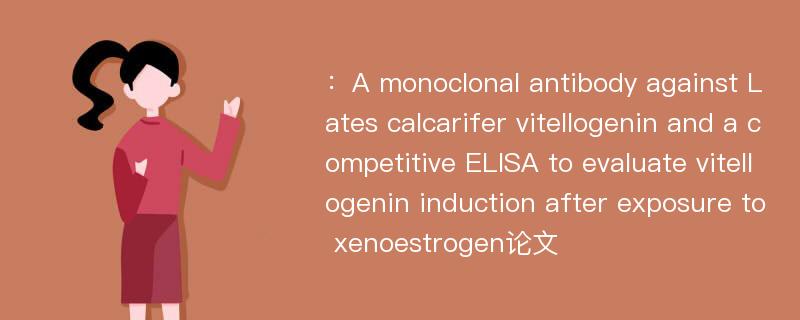
本文主要研究内容
作者(2019)在《A monoclonal antibody against Lates calcarifer vitellogenin and a competitive ELISA to evaluate vitellogenin induction after exposure to xenoestrogen》一文中研究指出:A monoclonal antibody specific to sea bass(Lates calcarifer) vitellogenin(VTG) was developed,for use as a tool for monitoring endocrine disrupting chemicals(EDCs). VTG was induced in sea bass by intramuscular injection of 17β-estradiol(E2: 2 mg/kg) every three days. Blood was collected three days after the last injection. Plasma VTG was then purified by chromatography in hydroxyapatite and a sephacryl-S300 column. Characterizations of purified VTG were done by phospholipoglycoprotein staining on a native-PAGE with confirmation by mass spectrometry(LC-MS/MS). Antibody was raised in mice by injection of purified VTG. After monoclonal antibody production, the hybridoma clone No. 41(MAb-sea bass VTG 41)was selected and developed for quantification of VTG by competitive enzyme-linked immunosorbent assay(ELISA). The ELISA method was sensitive with a detection limit of VTG 40 ng/mL. MAb-sea bass VTG 41 was specific to VTG from E2-treated sea bass and others EDCs(Nonylphenol, Benzo[a]pyrene and CdCl2). Moreover, cross-reactivity was also found in E2-treated coral grouper(Epinephelus corallicola). The ELISA method obtained from this work can be further applied for the assessment of EDCs in Thailand and Southeast Asia’s aquatic environment.
Abstract
A monoclonal antibody specific to sea bass(Lates calcarifer) vitellogenin(VTG) was developed,for use as a tool for monitoring endocrine disrupting chemicals(EDCs). VTG was induced in sea bass by intramuscular injection of 17β-estradiol(E2: 2 mg/kg) every three days. Blood was collected three days after the last injection. Plasma VTG was then purified by chromatography in hydroxyapatite and a sephacryl-S300 column. Characterizations of purified VTG were done by phospholipoglycoprotein staining on a native-PAGE with confirmation by mass spectrometry(LC-MS/MS). Antibody was raised in mice by injection of purified VTG. After monoclonal antibody production, the hybridoma clone No. 41(MAb-sea bass VTG 41)was selected and developed for quantification of VTG by competitive enzyme-linked immunosorbent assay(ELISA). The ELISA method was sensitive with a detection limit of VTG 40 ng/mL. MAb-sea bass VTG 41 was specific to VTG from E2-treated sea bass and others EDCs(Nonylphenol, Benzo[a]pyrene and CdCl2). Moreover, cross-reactivity was also found in E2-treated coral grouper(Epinephelus corallicola). The ELISA method obtained from this work can be further applied for the assessment of EDCs in Thailand and Southeast Asia’s aquatic environment.
论文参考文献
论文详细介绍
论文作者分别是来自Journal of Environmental Sciences的,发表于刊物Journal of Environmental Sciences2019年01期论文,是一篇关于,Journal of Environmental Sciences2019年01期论文的文章。本文可供学术参考使用,各位学者可以免费参考阅读下载,文章观点不代表本站观点,资料来自Journal of Environmental Sciences2019年01期论文网站,若本站收录的文献无意侵犯了您的著作版权,请联系我们删除。
